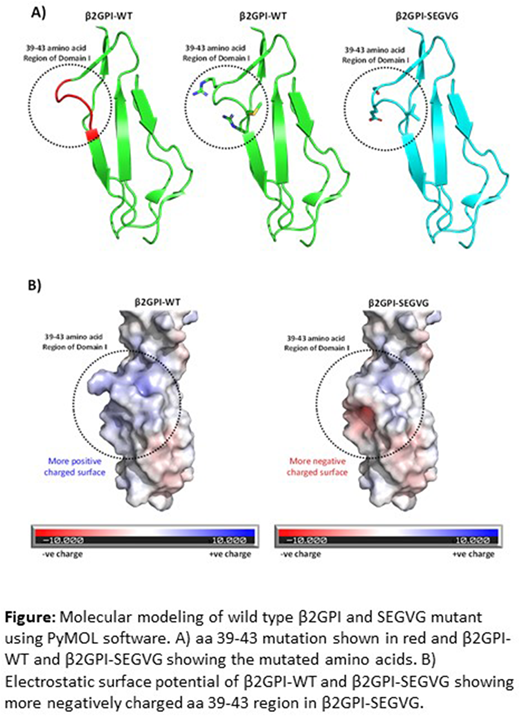Abstract
Introduction:
Antiphospholipid syndrome (APS) is an autoimmune disorder caused by "antiphospholipid" antibodies (aPL) directed against β2-glycoprotein I (β2GPI). In the presence of β2GPI, aPL activate endothelial cells through TLR4-mediated and other pathways. Previous studies suggest that a region encompassing amino acids 39-43 of β2GPI domain 1 comprises an important binding site for pathogenic aPL. However, due to difficulty in expressing full-length recombinant β2GPI, antibody specificity has only been tested using individual, recombinant β2GPI domains. Further definition of antibody specificity using intact recombinant β2GPI provides a new approach for diagnostic and mechanistic studies. In the present study we describe the expression of full-length, wild-type recombinant β2GPI and site-directed mutants encompassing the putative β2GPI binding region in domain 1. Binding of APS patient-derived anti-β2GPI antibodies to these proteins and their ability to support anti-β2GPI-mediated endothelial cell activation was determined.
Methods:
Full length APOH cDNA with a modified signal peptide (spm) was cloned into the lentiviral vector pLenti CMV Puro DEST. We generated two mutants spanning the 39 to 43 amino acid region: SEGVG (R39S; G40E; M42V; R43G) and AAGMA (R39A; G40A; R43A). The final recombinant plasmids were termed as pDEST-spmAPOH-WT; pDEST-spmAPOH-SEGVG and pDEST-spmAPOH-AAGMA. Lentivirus was produced using the Lentiviral Gateway Expression kit using GP2-293 (HEK) cells. Stable cell lines were generated by transducing HEK cells with APOH-lentivirus and selecting against puromycin. Stable cell lines were transferred to serum-free media and grown in suspension. Cell culture supernatants containing secreted β2GPI were filtered and concentrated, and recombinant β2GPI was purified using a hitrap-heparin column.
Anti-β2GPI antibody binding to plasma-derived and rβ2GPI was determined using a standard β2GPI ELISA and SPR (Surface Plasmon Resonance) on a Biacore 3000. Biosensor analysis was performed by crosslinking β2GPI to carboxymethyl-dextran coated sensor chips using amine coupling. Anti-β2GPI antibodies at concentrations ranging from 1-15,000 nM, were flowed through channels until equilibrium binding was achieved, at which point dissociation was assessed over a 10 minute interval. The BIAevaluation program was used to calculate association and dissociation rates. Endothelial cell activation was assessed by measuring cell surface E-selectin expression after incubating cells with control IgG or anti-β2GPI antibodies in the presence or absence of wild-type or mutant rβ2GPI. Molecular modeling was performed using PyMol.
Results:
After transduction with lentivirus encoding β2GPI with a modified signal peptide, HEK-293 cells were able to express and efficiently secrete rβ2GPI and site-directed mutants. Using a standard β2GPI-ELISA and SPR we found no significant differences in binding affinity of aPL towards plasma-derived and wild-type rβ2GPI. However, in the anti-β2GPI ELISA, binding of patient-derived aPL (APS21) to both mutants was reduced by ~70% compared to wild-type rβ2GPI. Consistent with binding specificity for a region encompassing aa 39-43, the Kd for binding of APS21 anti-β2GPI antibodies to wild-type and rβ2GPI-SEGVG determined by SPR was 20 nM and 5000 nM, respectively. Moreover, the ability of patient-derived APS21 anti-β2GPI antibodies to activate endothelial cells was reduced by >60% in the presence of rβ2GPI-SEGVG compared to wild-type rβ2GPI. Molecular modeling of β2GPI demonstrated that a mutation in the aa 39-43 region is predicted to cause a change from a net positive to a net negative charge without any structural change (Figure 1).
Conclusion:
These studies are the first to assess binding of human anti-β2GPI antibodies to rβ2GPI and site-directed mutants expressed in mammalian cells. No significant differences between binding of aPL to plasma derived and wild-type rβ2GPI were observed. APS21 aPL has specificity towards epitope 39-43 of β2GPI domain 1 and its binding affinity to rβ2GPI-SEGVG was significantly reduced. Functional studies demonstrate the importance of β2GPI aa 39 to 43 in supporting endothelial cell activation by anti-β2GPI antibodies. These recombinant proteins should facilitate further studies concerning the role of aPL-β2GPI interactions in the diagnosis and pathogenesis of APS.
No relevant conflicts of interest to declare.
Author notes
Asterisk with author names denotes non-ASH members.


This feature is available to Subscribers Only
Sign In or Create an Account Close Modal